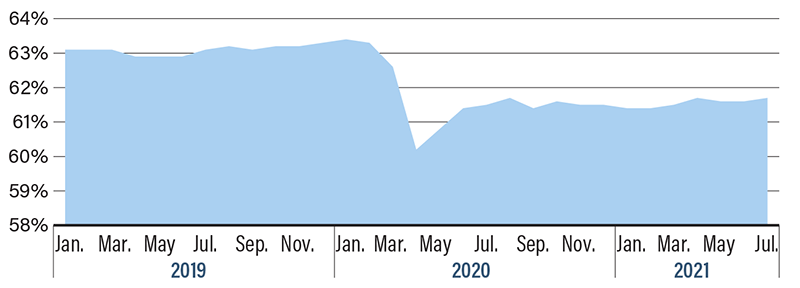What the Labor Market Needs: More Workers

The U.S. economy is in the midst of a historic comeback, but it’s happening with the lowest rate of labor force participation in more than four decades and a record number of vacant jobs. Sadly, the United States lags all of our peer countries in labor force participation, which is not where we want to be. More employed workers means stronger economic growth.
The labor force participation rate is the estimated number of people who are employed or actively looking for work divided by the estimated working-age population, excluding uniformed military personnel and those behind bars. Unfortunately, declines in the rate often reflect a weak labor market. The United States had a record 10.1 million job openings in June, which is more unfilled positions than at any time since the U.S. Bureau of Labor Statistics (BLS) started tracking the data in 2006.
The declining labor participation rate isn’t something new. According to a July 2018 BLS report, over the past 20 years, participation and employment rates have declined at a higher rate in the United States than they have in any other Organization for Economic Cooperation and Development country, particularly for workers aged 25 to 54. Add the pandemic reductions on top of that already-waning participation, and you’re looking at a loss of millions of workers. Why are men and women in their prime age leaving the workforce? The pre-pandemic study cited child care, incarceration, poor health and lack of job training. Today, you can add lingering fear of the virus, changed priorities in light of the events of the past year, continued child care challenges, drug dependency and, finally, automation. All these factors have an effect on prime age working men and women.
Unfortunately, there is no simple fix. The pandemic had a major impact on Americans in terms of work-life balance. Employees have been hesitant to return to jobs in industries that require a set schedule with in-person work. Employers are raising pay, offering new benefits and allowing more workers to remain partly remote in an effort to lure new hires.
For years, economists have predicted that a shrinking labor pool would act as a permanent drag on economic growth. That negative impact is now being felt.
Average Yearly Labor Force Participation Rate
 Source: Bloomberg
Source: Bloomberg
